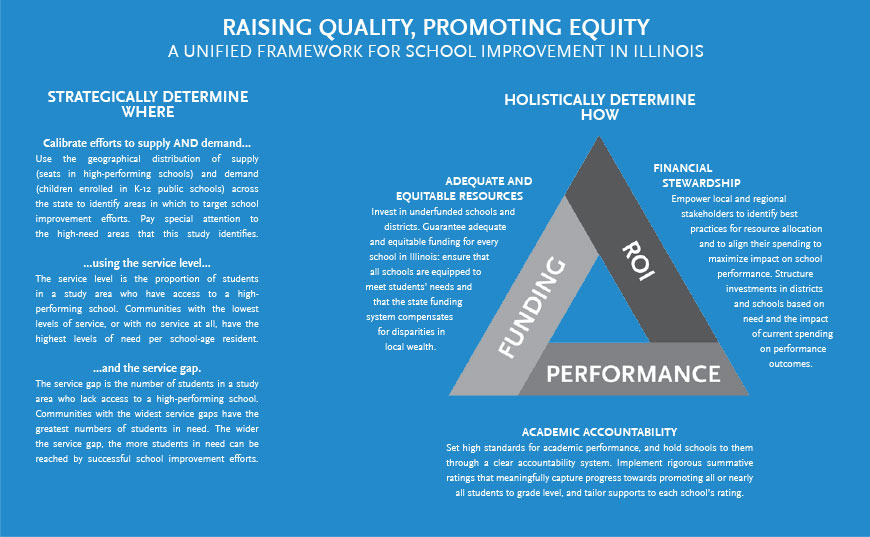 This September 2017 report by IFF found that, during the 2013-2014 school year, only 12 percent of Illinois’ K-12 students had access to a public school in which all or nearly all students were prepared to read, write, and do math at grade level— a threshold consistent with the Illinois State Board of Education’s goal of achieving 90 percent proficiency in reading and math by 2032. That leaves an estimated 1.6 million of the state’s K-12 students without access to a high-performing public school.
This September 2017 report by IFF found that, during the 2013-2014 school year, only 12 percent of Illinois’ K-12 students had access to a public school in which all or nearly all students were prepared to read, write, and do math at grade level— a threshold consistent with the Illinois State Board of Education’s goal of achieving 90 percent proficiency in reading and math by 2032. That leaves an estimated 1.6 million of the state’s K-12 students without access to a high-performing public school.
Raising Quality, Promoting Equity maps the substantial need for high-performing public schools across the state and provides essential data on the adequacy and equity of recent funding levels. It also explores the effectiveness of district spending. The report’s findings reinforce the state’s recent adoption of an evidence-based funding formula to ensure that all schools have sufficient funds to provide a quality education.
Combined, the study’s three components recommend a more holistic approach to school improvement by providing state, regional, and local education leaders with an important framework for action:
- A Needs Assessment that quantifies and prioritizes the need for high-performing schools across the state;
- An analysis of District Funding that gauges the adequacy and equity of school district funding in the years prior to the adoption of an evidence-based funding formula;
- A discussion of Return on Investment (ROI) that measures the effectiveness of school district spending for boosting core performance outcomes.
DOWNLOAD THE PDF | Highlights | Online Tool
Press questions may be directed to Jose Cerda III at 312 596 5124.
For a collection of earlier IFF education studies, please visit our research section.
Highlights

Academic accountability, adequate and equitable resources, and financial stewardship should represent a unified statewide effort to improve K-12 public schools. Performance, funding, and return on investment must be addressed jointly and holistically to raise quality and promote equity in public education in Illinois. The broad scope and deep reach of this collaborative agenda means that community, school, district, municipal, regional, and state leaders have interdependent roles to play, in conjunction with support from the nonprofit and philanthropic sectors. Raising Quality, Promoting Equity presents a framework through which all stakeholders can approach school improvement, allowing for differentiated responsibility without losing sight of common goals.
Better-performing public schools are needed throughout the state — in urban, suburban, town, and rural areas alike.
- In 95 percent of the 234 areas studied, most students did not have access to a high-performing public school.
- In about half of the 234 areas studied, there were effectively no high-performing public schools.
- Only two study areas, both in Chicago’s affluent North Shore suburbs, had enough seats in high-performing public schools to serve all students living there.
The state’s public education system fails to fulfill a basic function of public education: equalizing opportunity.
- In Illinois, test scores gauge family wealth almost as well as they measure reading and math ability. In the state’s wealthiest communities, a low-performing school is a rare exception; in its poorest communities, it is the norm.
- Some of the highest-need communities included: Sangamon County, including Springfield (#1); various neighborhoods on the west, southwest, and northwest sides of Chicago (#2, #3, #6, #13); Champaign (#4); Elgin/South Elgin (#5, #15); Bloomington (#7); Carpentersville (#8); Rock Island (#9); Cicero (#10); Rockford (#11); Kankakee (#12); and LaSalle (#14).
Measures of return on investment (ROI) can help stakeholders understand how effectively districts promote math and reading proficiency; the adequacy and equity of school funding explain whether they have enough resources to do so in the first place.
- Fifty-seven percent of public school students were enrolled in school districts that were underfunded or borderline underfunded in 2013-14, after adjusting for local costs and student needs.
- With the major exceptions of Chicago, some of its suburbs, and Kankakee — which include a large portion of the state’s students — underfunded school districts tended to be located in the southern half of the state (Springfield and below).
- Whereas an underfunded school district was an exception in higher-income areas of the state, it was the norm for families in Illinois’ low-income communities.
- Although funding alone does not tell the whole story of school performance, there is a link between adequate funding and academic outcomes. Four out of five high-performing schools were in adequately funded school districts. Almost no school district achieved high levels of academic performance in the absence of adequate funding.
- Not every school district that was underperforming made poor use of its resources. In fact, 147 underperforming districts had high ROI: they more cost-effectively achieved math and reading proficiency than even some better-performing districts.
- On average, districts with high ROI spent less on overhead and more on instruction than districts with lower ROI.
Online Tool
The data visualization suite that accompanies this report allows users to compare schools, districts, and study areas of their choosing with the state and with customizable sets of peer schools, districts, and study areas. For example, a user interested in a particular high-income, suburban school district could see how that district’s outcomes in performance, funding, and return on investment (ROI) compare to similar school districts and/or to state averages. Click here to see the full online tool in a new window.